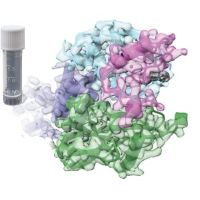Specification
| Description | Recombinant protein from the full-length sequence of Homo sapiens chloride channel accessory 2 (CLCA2) (NM_006536). |
| Organism | Homo sapiens (Human) |
| Expression Host | Human Cells |
| Tag Info | His or DYKDDDDK. Please contact us if you need further information or require specific designed tag. |
| Purity | Greater than 90% by SDS-PAGE gel |
| Uniprot ID | Q9UQC9 |
| Entry Name | CLCA2_HUMAN |
| Gene Names | CLCA2 CACC3 |
| Alternative Gene Names | CACC3 |
| Alternative Protein Names | Calcium-activated chloride channel regulator 2 (EC 3.4.-.-) (Calcium-activated chloride channel family member 2) (hCLCA2) (Calcium-activated chloride channel protein 3) (CaCC-3) (hCaCC-3) [Cleaved into: Calcium-activated chloride channel regulator 2, 109 kDa form; Calcium-activated chloride channel regulator 2, 35 kDa form] |
| Application | Antigens, Western, ELISA and other in vitro binding or in vivo functional assays, and protein-protein interaction studies; For research & development use only! |
| Buffer | Purified protein formulated in a sterile solution of PBS buffer, pH7.2, without any preservatives |
| Endotoxin | Endotoxin level is < 0.1 ng/µg of protein (<1EU /µg) |
| Length | 943 |
| Molecular Weight(Da) | 103941 |
| Protein Sequence | (The sequence of expressed protein may have some variation from the sequence shown below. Please contact us for the exact sequence.) MTQRSIAGPICNLKFVTLLVALSSELPFLGAGVQLQDNGYNGLLIAINPQVPENQNLISNIKEMITEASFYLFNATKRRVFFRNIKILIPATWKANNNSKIKQESYEKANVIVTDWYGAHGDDPYTLQYRGCGKEGKYIHFTPNFLLNDNLTAGYGSRGRVFVHEWAHLRWGVFDEYNNDKPFYINGQNQIKVTRCSSDITGIFVCEKGPCPQENCIISKLFKEGCTFIYNSTQNATASIMFMQSLSSVVEFCNASTHNQEAPNLQNQMCSLRSAWDVITDSADFHHSFPMNGTELPPPPTFSLVQAGDKVVCLVLDVSSKMAEADRLLQLQQAAEFYLMQIVEIHTFVGIASFDSKGEIRAQLHQINSNDDRKLLVSYLPTTVSAKTDISICSGLKKGFEVVEKLNGKAYGSVMILVTSGDDKLLGNCLPTVLSSGSTIHSIALGSSAAPNLEELSRLTGGLKFFVPDISNSNSMIDAFSRISSGTGDIFQQHIQLESTGENVKPHHQLKNTVTVDNTVGNDTMFLVTWQASGPPEIILFDPDGRKYYTNNFITNLTFRTASLWIPGTAKPGHWTYTLNNTHHSLQALKVTVTSRASNSAVPPATVEAFVERDSLHFPHPVMIYANVKQGFYPILNATVTATVEPETGDPVTLRLLDDGAGADVIKNDGIYSRYFFSFAANGRYSLKVHVNHSPSISTPAHSIPGSHAMYVPGYTANGNIQMNAPRKSVGRNEEERKWGFSRVSSGGSFSVLGVPAGPHPDVFPPCKIIDLEAVKVEEELTLSWTAPGEDFDQGQATSYEIRMSKSLQNIQDDFNNAILVNTSKRNPQQAGIREIFTFSPQISTNGPEHQPNGETHESHRIYVAIRAMDRNSLQSAVSNIAQAPLFIPPNSDPVPARDYLILKGVLTAMGLIGIICLIIVVTHHTLSRKKRADKKENGTKLL |
Background
| Function | FUNCTION: Plays a role in modulating chloride current across the plasma membrane in a calcium-dependent manner, and cell adhesion. Involved in basal cell adhesion and/or stratification of squamous epithelia. May act as a tumor suppressor in breast and colorectal cancer. Plays a key role for cell adhesion in the beginning stages of lung metastasis via the binding to ITGB4. {ECO:0000269|PubMed:10554024, ECO:0000269|PubMed:11320086, ECO:0000269|PubMed:11445004, ECO:0000269|PubMed:15707651, ECO:0000269|PubMed:16158324}. |
| Pathway | |
| Protein Families | CLCR family |
| Tissue Specificity | Expressed in cornea, skin, vagina, esophagus, and larynx (at protein level). Expressed in trachea and mammary gland. Weakly expressed in testis and kidney. Highly expressed in corneal epithelium, colon and trachea. Moderately expressed in brain, urogenital organs, bladder, uterus and prostate. Highly expressed in tissues containing stratified epithelium including cornea, esophagus, larynx, skin and vagina than those tissues which contain only epithelial monolayers. Expressed in normal breast epithelium but not in breast cancer. Highly expressed during epithelial stratification. Expressed in endothelial cells of lung. Expressed selectively in endothelia of small pulmonary arteries, arterioles, and subpleural and interlobular venules. {ECO:0000269|PubMed:10362588, ECO:0000269|PubMed:10437792, ECO:0000269|PubMed:10554024, ECO:0000269|PubMed:11262615, ECO:0000269|PubMed:11320086, ECO:0000269|PubMed:14966209, ECO:0000269|PubMed:15707651, ECO:0000269|PubMed:16158324}. |
QC Data
| Note | Please contact us for QC Data |
| Product Image (Reference Only) |  |

